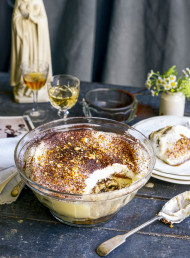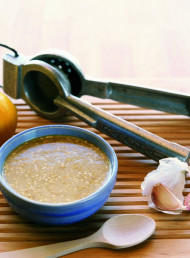A guide to: culinary herbs
Photography by Manja Wachsmuch.

Culinary herbs are a cook’s best friend – Sarah La Touche explains which ones you need to have on hand in the kitchen...
Whether it’s sprigs of rosemary dotted into a leg of lamb, coriander leaves sprinkled over a Thai green curry, or mint chopped through strawberries, culinary herbs can add delicious complexity to the plainest of dishes.
Herbs can bring character and depth, or complement and accentuate when added to a sauce, braise or soup, chopped and ground to make a rub, paste or pesto, tossed through a bowl of crisp lettuce leaves, or used simply as a beautiful garnish.
The leaves of a herb contain a mix of water and volatile oils. A herb’s flavour and aroma are stored in the oils, which is why they are tastiest fresh. As with all oils, when exposed to strong sunlight, excess oxygen or intense heat, the aroma molecules become damaged and lose their pungency. This is why some dried herbs end up tasting and smelling like hay – as the water evaporates, so too does the oil.
Freeze-dried herbs defy this phenomenon, however. A complicated but efficient process preserves the flavour in the oils, meaning freeze-dried herbs are pricier than standard dried herbs but the intensity of flavour is far superior.
TYPES OF CULINARY HERBS
Basil – this annual worships warmth and sunshine. There are numerous varieties from broad-leafed, perfumed and mildly spicy, to the small-leafed bush basil, which is intensely flavoured and famous for making Genovese pesto and soupe au pistou, a fresh vegetable soup from France. The attractive purple-leafed variety is slightly tougher in texture but equally tasty, while Thai basil is hot, aromatic and anise-flavoured. Flavour profiles depend on the variety, growing conditions and the stage at which the basil is harvested. It is great with tomatoes, eggplant, garlic, pasta, chilli, grilled capsicum, ricotta or fresh mozzarella, olive oil and lemon. Chop or tear when adding to dishes, but either way do it at the last minute as an enzyme in the leaves will turn them brown if left too long.
Bay leaves – from the evergreen bay laurel tree, which is native to the Mediterranean. Highly fragrant with notes of eucalyptus and clove, the leaves are commonly used dried to flavour sauces, stocks, soups, casseroles and many meat dishes. Use it fresh for extra zing in marinades and discard before serving or leave in to garnish. Crumble it onto barbecue coals to perfume grilled meats and fish. Can be used with practically anything savoury.
Chervil – one of the essential herbs in the classic French fines herbes mix (see pg 63). It has small, delicate leaves similar in shape to coriander. The flavour is elegant with hints of anise or tarragon and is superb with shellfish and white fish, or to flavour fine sauces. Chervil also makes a handsome garnish.
Coriander – known as cilantro in the USA, this native of the Mediterranean has a fresh, heady fragrance with a slight aniseed flavour and waxy texture. Synonymous with South-East Asian and Mexican cooking, the leaves are used fresh mostly, as its flavour diminishes when heated. The roots and stems can be pounded to make stunning curry pastes and marinades. Add the stems to soup bases for background flavour.
Chives – part of the onion family with flat, intensely flavoured leaves that grow from a mass of tiny bulbs. Chinese chives are slightly bigger with a garlicky hint. Chives are fantastic added to dressings, sauces, folded through a savoury scone mix or added at the last minute to
bacon and egg pie or a goat’s cheese tart. Use chives to garnish dishes either chopped or whole. They like to be paired with seafood and poultry, eggs, cheese, salad greens and beetroot.
Curry leaves – from a small shrub related to citrus, and a native of Southern Asia, they don’t actually taste of curry but have a sweet, musky fragrance. Use them fresh or dried in Asian curries, dahls, vegetable dishes and soups. Sauté in a little ghee (Indian clarified butter) or oil with other spices before adding the main ingredients, and leave them in the dish during cooking. Available fresh at many Asian specialty stores. They also freeze well.
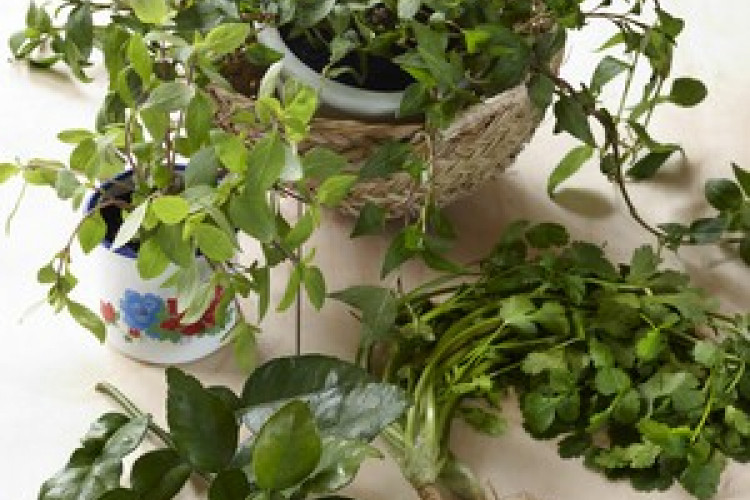

Dill – feathery, dark green fronds which add a delicious freshness to food. This herb was made to go with salmon, sour cream and pickled gherkins. Toss it through cooked beetroot with yoghurt, fold through creamy, cold potato salad or sprinkle over green salads, peas and rice. The seeds can also be used in much
the same way as fennel – try adding
to a vinaigrette.
Fennel – another member of the carrot family, with slightly coarser, feathery foliage. Fennel is best known for its seeds, or the root bulbs of Florence fennel, but the leaves
are equally flavoursome. With its distinct sweet anise aromas it is a natural companion to fish. Bake a whole trout on a bed of fennel leaves or stuff some into the cavity of a whole snapper. Use in fish stock, bouillabaisse, in salads, to grill young rabbit or small poultry.
Hyssop – fresh, spicy and aromatic with notes of anise. Hyssop is one of the flavour components for making liquorice, the liqueur Chartreuse, and the perfume Eau de Cologne. It is used in Asian cooking, especially Thai and Vietnamese cuisine. Use the leaves sparingly
in salads and soups, and chopped finely in marinades for meat.
Kaffir lime leaves – also known as Makrut, this member of the citrus family has dark, shiny, intensely aromatic leaves used to perfume many Thai, Laotian and other South-East Asian dishes. The leaves have fresh, citrusy, lingering green notes – use like bay leaves when adding to soupy curries. They are excellent with fish, meats, tropical fruits like mango and papaya, and sticky rice puddings. The leaves can be shredded finely (known as cutting en chiffonade) and used as a garnish or to perfume rice dishes. The rind can be grated into salads and sauces, but is less remarkable in flavour. The pith and juice of the fruit is quite bitter and unappealing. The leaves can also be frozen.
Lemon balm – citrusy, floral and fresh, lemon balm makes a refreshing tea. Chop the leaves finely and sprinkle through strawberries or other summer fruits with some sweet wine like
Muscat or Dubonnet. Pop into cooling cocktails or cordials or
flavour delicate sauces to serve with fish or chicken.
"A herb's flavour and aroma are stored in the oils, which is why they are tastiest fresh."
Marjoram – belongs to the mint family and has an intense, aromatic flavour. Beautiful in salads and a myriad of vegetable dishes, with grilled meats and fish, as well as pulses like lentils, chickpeas and white beans. Very good with shellfish and squid or try chopping into a fresh carrot salad with toasted almonds or peanuts. The flavour can diminish with cooking, so add towards the end, or use raw.
Mint– a large family with a range of flavour profiles. Spearmint (or common mint) and peppermint are the most common. Use them in sweet and savoury dishes, with fruit like strawberries or pineapple, or make a fresh mint sauce with sugar, water and a dash of vinegar, to serve with spring lamb. Chop and fold mint through grains like couscous or quinoa, or add to stuffings. Vietnamese mint has a distinctive long pointed leaf and a wonderfully refreshing flavour. Use to garnish Asian soups like laksa or stir-fries. Most pungent when used fresh.
Oregano– also referred to as wild marjoram, oregano is another member of the mint family, with more than 40 different species ranging from mild to intense. Greek oreganos are famous for their richness. Oregano becomes even stronger when dried – Sicilian oregano is an example of this. Use in pasta sauces, on pizza, for garnishing flat breads, with grilled meats (especially lamb) or to flavour soups.
Parsley – perhaps one of the most well known of the culinary herbs, its distinct green, almost metallic flavour goes with so many foods. Flat-leafed (also known as Italian) parsley is strongest when young, while the curly-leafed variety starts out mild then becomes much more intense. Parsley is essential in a bouquet garni, for making stocks, flavouring butters and sauces and as a garnish.
Rosemary – a must-have when marinating meats, especially lamb. This aromatic evergreen shrub is also great with tomatoes, fish, pork, and beef. Use it finely chopped to make sweet sablé biscuits or look for rosemary flavoured honey to drizzle over ice cream. Even the ornamental shrubs can be used in cooking.
Sage – with around 1000 species in the family, the most common cooking varieties are green or purple sage; pineapple sage (a sweeter milder version), or clary sage, which is perfect for making tea. Use in stuffings for poultry or pork, as a rub for grilling meats, chopped finely and folded through gnocchi, or mixed with ricotta to stuff ravioli. Try two leaves with an anchovy in the middle to deep-fry as a crispy flavoursome pre-dinner nibble, or simply pan-fry the leaves in good butter and pour over zucchini or poached broad beans. A stunning herb to use in meat braises and stews.
Tarragon – Russian tarragon is bitter and not worth using in cooking but cultivated French tarragon contains a phenol called estragole, giving it an attractive anise, almost tongue-numbing flavour. Use tarragon fresh with chicken, eggs, cream and asparagus, for pesto or in salads. Use it dried in sauces like the classic Béarnaise, in the French fines herbes, or to flavour vinegars or poaching liquids.
Thyme – a low growing perennial native to the Mediterranean basin, there are some 60 -70 species of thyme. Thymus vulgaris is the most common, with heady, spicy aromas. It is ideal for adding to a bouquet garni when making stocks or poaching meats and fish. Add it to soups, braises or stews for depth of flavour, or throw stems on the barbecue when grilling meats. Lemon thyme has small grey-green leaves and loves pairing with poultry, dark, oily fish or white meats like rabbit. Pizza thyme has a dark green robust leaf with a less intense flavour. As the name suggests, it goes well with tomato sauces sprinkled over a delicious homemade pizza. All thymes are most intense when in bud just before flowering.
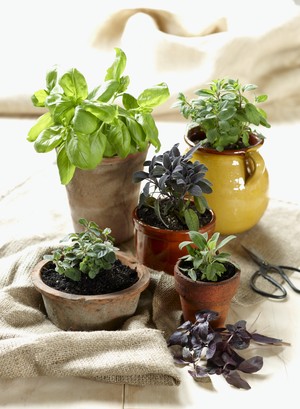
Clockwise from top left: basil, marjoram, purple sage, sage, purple basil, oregano.
STORING HERBS
Freshly cut herbs can be stored for easy use. Wrap them loosely in a paper towel (to help absorb moisture and reduce spoilage) and then place in a plastic bag and store on the lower shelf of your refrigerator.
Softer herbs such as basil, coriander and flat-leaf parsley are best kept at room temperature with the stems sitting in a little water. Trim the stems daily for optimum freshness.
Freezing works well for tougher leaves such as bay, curry and kaffir lime. You can also freeze soft-leafed herbs like chives, basil, tarragon, parsley, coriander, lovage and dill, although they will never be suitable for garnishes. Because of their high water content the freezing process damages the structure of the herb, while the flavour remains. Use these herbs to add to soups, sauces and stews. They will keep for six months in the freezer.
To freeze, lay the herbs out on a baking tray lined with baking paper and freeze. Then place the frozen herbs in an airtight freezer bag and return to the freezer. Or roughly chop the leaves and pack them into ice cube trays, each about one third full. Fill with water or stock and freeze. Remove and tip into freezer bags for storage. Basil can be puréed with olive oil and frozen this way without the water.
NEW ZEALAND NATIVES
Horopito – the leaves from a plant also called New Zealand pepper tree. Use it dried as a condiment for adding bite to meat rubs, curries, or marinades. It can also be infused in culinary oils for dressings, and cooking meats and fish. Mix with sea salt to spice up a steak on the barbecue. Proven to contain anti-fungal and antioxidant properties.
Kawakawa – an innocuous shrub with deep green heart-shaped flat leaves. Sometimes referred to as Maori bush basil, the leaves are used mostly dried as a rub or flavouring for meats and fish. They can also be picked fresh though and steeped to make a tea for medicinal purposes.

DRYING YOUR OWN
Many herbs can be dried at home to preserve them for use over colder months. Air-drying is the safest and cheapest way. Harvest the herbs late evening or early morning with scissors, keeping the stems long. Wash them if you must but make sure they are dried well in a salad spinner or with a hair drier on low as any residual moisture can cause mould and spoilage. Remove any damaged foliage and bundle them up. Take a large paper bag punctured with air holes for ventilation and place that loosely over the herbs. Tie with string at the base and hang upside down in a warm, dry place (around 20°C is ideal) for 1-3 weeks, depending on the climate. Check for mould from time to time.
Herbs that grow well in hot, dry conditions like sage, rosemary, oregano, marjoram, thyme and bay all dry well this way. When they are crisp and dry, drag your thumb and fingers along each stem to remove the leaves. Store in airtight glass jars in a dark place. Dried herbs are best used within one year. Dried herbs are considered more potent than fresh; as a rule of thumb 1 teaspoon of dried herbs is equivalent to 1 tablespoon of fresh.
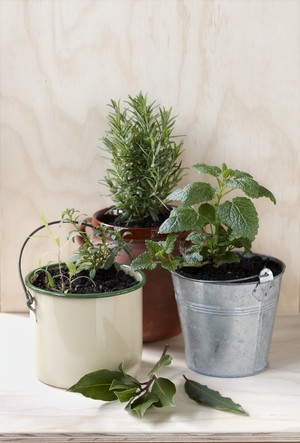
From left: French tarragon and hyssop (in cream pail), rosemary, lemon balm,
bay leaves.
HERBS IN COOKING
Fines herbes: a mixture of chopped aromatic herbs (usually parsley, chervil, tarragon and chives) used to flavour soups, sauces, marinades etc.
Bouquet garni: a selection of aromatic herbs, usually tied together or wrapped in a muslin cloth, used to flavour dishes but removed before serving. You can make your own with a few sprigs of parsley, a sprig of thyme and a couple of bay leaves tied with kitchen string. Bouquet garni are also available in packets from the supermarket or specialty food stores.
latest issue:
Issue #120
As the days become shorter, and the nights cooler, the latest issue is perfectly timed to deliver delicious autumn dishes. From recipes using fresh seasonal produce such as feijoas and apples, to spectacular soothing soups and super-quick after-work meals in our Food Fast section, we’ve got you covered. With Easter on the horizon, we feature recipes that will see you through breakfast, lunch and dinner over a leisurely weekend holiday, and whip up chocolatey baking treats sure to please. We round up delicious dinners for two and showcase a hot new Korean cookbook before heading south to Dunedin to check out all that’s new in food and dining.The latest issue of dish is on sale NOW at all good bookstores and supermarkets – don’t miss it!


